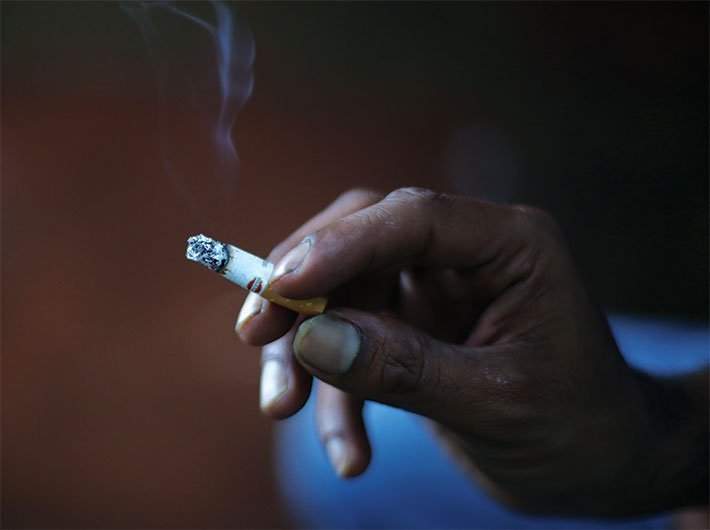Cessation support needs to go far beyond phone counselling and offering encouragement to quit
The two-month Covid-19 lockdown has been both a bane and a boon for India’s 27 crore tobacco users. With tobacco not included in the list of essential goods and many states explicitly banning chewing tobacco over concerns of spitting, the sharp drop in availability has forced them to undergo withdrawals, but for many it has lit a desire to quit altogether. This presents a rare opportunity to drive down the country’s enormous tobacco disease burden, but can be easily missed like the post-ban rush outside liquor shops if the state does not take immediate steps.
The Indian government has imposed among the world’s harshest restrictions on tobacco use during lockdown, only South Africa’s is comparable in severity, as tobacco shops across the country have stayed shut and no online sales are allowed. Some of this impact has been blunted by the mushrooming of a black market, with cigarettes being sold at twice the normal rates. This is an expected feature of prohibition that can have long-term negative consequences. Even so, given that tobacco use claims over 10 lakh Indian lives every year, these restrictions could yet yield positive outcomes.
There is evidence that the lockdown has led to renewed desire to quit among Indian tobacco users, and most encouragingly, among younger users. A five-nation study found that two-thirds of the 1,500 smokers surveyed in India expressed a desire to quit, with the trend especially pronounced among younger smokers who have attempted to quit recently. At population level, this would add up to 20 crore people trying to quit. A prolonged lockdown has achieved what global tobacco control efforts have been struggling with for decades. And yet, this once-in-a-lifetime opportunity can be lost if measures are not taken to capitalise on it with urgency.
Providing meaningful cessation support requires going beyond the quit lines that offer encouragement and little else, and hence aren’t very effective. Tobacco dependence has to be understood within the framework of addiction—a smoker does not wake up and ‘choose’ to light up—which needs adequate behavioural and pharmacological support to address. While the severity of nicotine dependence is often overstated (“more addictive than heroin,” the health minister recently told parliament), there is no corresponding seriousness in providing quit support, all state efforts relying solely on willpower which no one would recommend to a heroin addict. No surprise that the majority of cold turkey quit attempts fail.
Chances of success are improved with nicotine replacement therapies (NRTs) such as gums and patches, which the World Health Organisation (WHO) has recommended for inclusion in the list of essential medicines. While smokers find quitting through nicotine gums tougher as they are used to inhaling nicotine than ingesting it, NRTs can be more effective for smokeless tobacco (SLT) users, who outnumber smokers in India by 2:1, totalling nearly 20 crore people.
The problem however is that NRTs are unaffordable to a vast majority of even cigarette smokers in India, leave alone the far bigger population of bidi and SLT users. A quick analysis shows one nicotine gum, roughly equivalent to a cigarette in dosage, costs more than a stick of the most common Indian cigarette brand. To provide effective support for tobacco users looking to quit, it is therefore essential that the government immediately subsidise NRTs and make them widely available as possible. While significant relief packages are being announced for Covid-19, it is good to be mindful that tobacco use is a bigger pandemic, claiming 8 million lives globally every year, and the cost of the NRT subsidy will be more than recovered by the savings in treatment expenses and mortality losses.
Efforts to protect the health of tobacco users can go further through harm reduction measures, which are best understood in the context of Covid-19 response. Just as public social distancing norms and use of masks can help salvage the economy battered by lockdowns, lower-risk alternatives can help save the lives of tobacco users who are unable to quit. It is a humane, pragmatic and scientific approach to a problem which cannot entirely be solved through raising taxes and even prohibition. The Indian government recently banned nicotine vapour systems over fears of teen uptake, while discounting the negative impact it will have on India’s nearly 10 crore smokers who would have benefited from the option to switch to a risk-reduced method of nicotine intake.
For SLT where too there is great risk variance in products, with Indian SLT rated among deadliest in the world due to the absence of quality standards and a monitoring authority, facilitating transferral to Swedish snus at the lower end of the harm spectrum can yield positive health outcomes. Snus can be made locally and, with some government support, at price points that enable a switch.
Finally, it is vital to better understand tobacco use patterns, effective intervention methods and emerging technologies and further to integrate this knowledge into our cessation programmes, which can be achieved through sustained government research grants and scientific evaluation.
A lot is possible, but there is an opportunity cost to inaction. What the Indian government does in the coming days will shape the trajectory of the country’s response to its tobacco crisis that drains the economy of Rs1 lakh crore every year.
Samrat Chowdhery is a former journalist and tobacco harm reduction expert.
